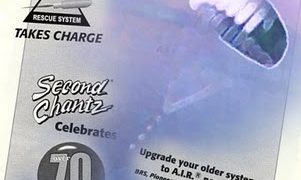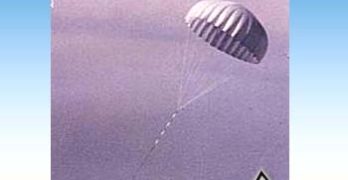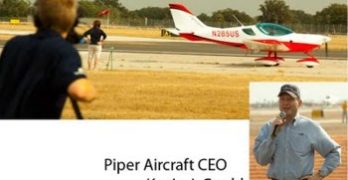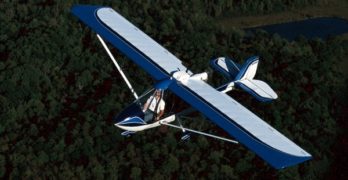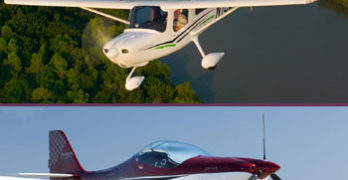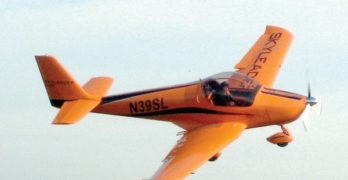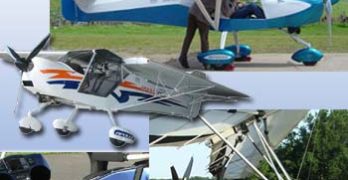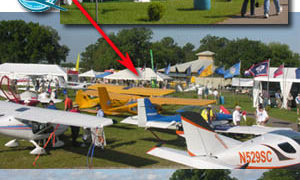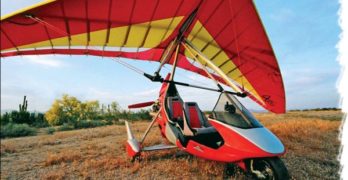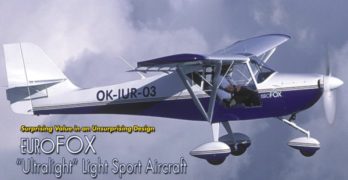Just out of a 3-day stomach bug sick bed, I must still be a bit delirious ’cause that old Sinatra tune, “Love is wonderful, the second time around” keeps winding through my fuzzy brain. *** No doubt I’m subconsciously morphing into music the news I got yesterday from old hang gliding pal and ultralight/light sport entrepreneur John Dunham that he’s back, in the biz he made so successful in the ’80s – Second Chantz Aerial Survival Equipment. *** His company sold more than 4,000 ballistic recovery systems when it was in operation, and has documented more than 70 saves worldwide. *** You can read all the gore-y details on John’s blog linked above but a brief bio must include his deep hang gliding/ultralight/LSA background as pilot, test pilot, instructor and savvy manufacturer/businessman from the early ’70s. He’s an all-around talent, this guy! *** John’s Flight Design West biz in Nevada marketed several LSA including the Flight Design CT and the lovely (and we hope soon-to-be-resurrected) Lambada motorglider.
Search Results for : BRS parachute
Not finding exactly what you expected? Try our advanced search option.
Select a manufacturer to go straight to all our content about that manufacturer.
Select an aircraft model to go straight to all our content about that model.
It’s B-A-C-K! Second Chantz Returnz to Chutz
Once Upon a Time… Two companies competed vigorously for the airframe (ballistic) parachute market. One was BRS. The other was Second Chantz, run by longtime proprietor and system designer, John Dunham. In a deal back in 1995, John agreed to cease competing with BRS, which went on to fame and fortune with the parachute for Cirrus airplanes and LSA. *** Now, zap forward a decade and a half. BRS is working hard to be a military contractor, and — while still pursuing the airframe parachute business with a couple larger customers — their corporate focus is elsewhere. I say “good luck with that” but the light aircraft community badly needed another company to offer services: repacking, repairs and maintenance, and new systems for aircraft BRS had no time to assist. *** Why start a company now, after 15 years of being out of the business, and with the country in a deep recession?
Enter the PiperSport!
Piper Aircraft’s Prez/CEO Kevin J. Gould made it official today at Sebring: the company has entered into a new, worldwide-exclusive distributor licensing agreement with Czech Sport Aircraft that will bring the SportCruiser to market – by April! – under the new name PiperSport. *** As I reported yesterday, Piper did not buy into the company as had been rumored. *** Piper representatives told me there will be some changes to the aircraft, such as refining control harmonies, to optimize its conformability to Piper’s long heritage of entry-level airplanes. *** But by and large, this is still the SportCruiser, which is a fine, Euro-proven design that is not only an excellent training airplane but most definitely a lot of fun to fly, and a dream to land. *** CEO Gould and other Piper personnel addressed a gathering of public and media to make the important announcement. *** Gould began his remarks by evoking the original Piper Cub, what he described as “one of the original ‘LSA’ aircraft of its time.” *** “Piper is entering what is undeniably one of the most exciting market segments in general aviation,” he continued.
Modestly-Priced, Easy-Flying Challenger Series
For 21 Years, Quad City’s Challenger has proved a good choice.
It’s enough to create a serious case of envy among producers vying for the market the Challenger seems to own year after year. Even in 2003, a slow year for all aircraft manufacturers, Quad City Ultralight Aircraft pumped out another 120 kits. Most light-sport aviation companies would consider that an excellent performance. For Quad City, it was a down year!
The venerable company from the Quad Cities area of Iowa, near the Illinois border, has put more than 3000 aircraft in the air. Van’s Aircraft has done even better, and Quicksilver has more than 10,000 ultralights flying, but the Challenger is clearly one of the industry’s leaders. And the company has enjoyed the same leadership since it was founded more than two decades ago.
Despite this success, Quad City maneuvers rather quietly. Last year the company celebrated 20 years of operation, yet many ultralighters and most aviators were unaware of the accomplishment.
Flying through Turbulence; Even Big Boys Affected
Most producers in the Light-Sport Aircraft sector welcomed the LSA market entry announced by Cessna and Cirrus at Oshkosh 2007. July of last year looks like the “good old days,” as aviation from LSA to VLJs — essentially all of GA — is roiled by global economic uncertainty. *** Compounding the challenges, Cessna had an “unrecoverable” spin incident with their Skycatcher 162. Even BRS got drawn in with a rocket-deployed parachute that for reasons yet unknown didn’t save the airframe. Both companies are sure to work out these issues; test failures are an accepted part of aircraft development. *** Cirrus stepped down to a 3-day workweek (AvWeb article) to cope with slowing sales. Like Cessna, Cirrus is managing multiple developments. Their jet project consumes plenty of resources so when watching costs, it’s little surprise that the Duluth company might put their SRS Light-Sport project on the back burner.
SkyLeader’s Wide-Body LSA
Update Note (2021) — This article published in 2008. The aircraft was then referred to as Skyleader 500. Later this was further upgraded and became the Skyleader 600. Obviously, some information presented below will be dated but much of the flight qualities reporting is still useful. —DJ
Sky Leading KP-5
First, Americans became aware of Kappa. This corporate identity was more easily pronounced than the next company name,
Jihlavan (roughly, “YEE-lah-von”) Airplanes. Now, after new investment and with new global ambitions, the company will be known a “Skyleader Aircraft.” American tongues can relax with this easy reference.
Unchanged are a common owner and the same skilled Jihlavan Airplanes
technicians building the elegant KP-5/Skyleader 500 from the Czech
Republic. It may not be the biggest seller among light sport aircraft (LSA),
but I find it to be one of the finest flying machines in the fleet. Skyleader
plans to standardize the brand around the world and will rename the KP-5
the Skyleader 500.
Fixed Wing or Flexible…TampaBay Has Choices
Our SLSA (Special Light-Sport Aircraft) List is popular with visitors and often generates a heads-up from alert readers about some new SLSA approval that snuck under my radar. This time the heads-up made me aware of new models in two forms. *** Please welcome TampaBay AeroSport’s Apollo Fox airplane and Monsoon weight-shift trike, to which I’ve assigned SLSA numbers 80 and 81. TampaBay, aka Apollo Aircraft, has been deeply involved with Light-Sport Aircraft for some time and previously won approval for the Delta Jet trike, which sells for a reasonable $38,000. Monsoon is a sleek, highly-engineered trike available with Rotax 582 or either 912-series engine for $45,000 to $58,500. *** In early 2008, the Florida Zephyrhills airport-based TampaBay also won an airworthiness certificate for their fixed wing Apollo Fox airplane. This European two seater is a variation of the popular design originated by Avid and Kitfox.
Big Crowds at the Sun ‘n Fun LSA Mall
Sun ‘n Fun 2008 is history, but planning is already underway for the 2009 event. Event boss John Burton confirmed we will again have the LAMA-hosted LSA Mall right at the front gate next April 21-26. A major success at this year’s Lakeland, Florida airshow, the industry Mall presentation featured 17 Special Light-Sport Aircraft. Weather prevented Fantasy Air’s Allegro from attending. Two days before the event, a tornado crushed a Sting S3 planned for display. And work at Quicksilver Manufacturing postponed the exhibit of the GT500 (they’re finishing SLSA approval, reports national sales manager, Todd Ellefson). *** The 17 who were in the ’08 LSA Mall enjoyed significant traffic all week and virtually every visitor to Sun ‘n Fun was at least exposed to Light-Sport Aircraft in a wide variety (although we were not able to enlist any trike or powered parachute companies).
A Sport Bike of the Air
First weight-shift S-LSA sets the bar high
In street vernacular, the term
“crotch rocket” refers to a lean,
lightweight, high-performance
motorcycle. Sometimes called sport
bikes, these machines have become
radically snazzy in modern years by
the addition of rakish body panels.
Sport bikes accelerate like a rocket.
They corner tightly, and they turn
heads wherever they go.
The first weight-shift trike to earn
special light-sport aircraft (S-LSA) approval,
the Air Creation Tanarg might
be compared to just such a vehicle. In
fact, that’s precisely how its French
manufacturer describes its newest
machine.
Yet, while sport bikes are touchy
and have less margin for error than
other motorcycles, Air Creation’s flying
sport bike is highly stable with predictable
handling. Compare Tanarg’s
performance to other trikes, and it
comes out as a top-of-the-line entry.
The name Tanarg comes from the
highest mountain range in the Ardeche
region of southern France, not
far from the Air Creation factory.
Surprising Value in an Unsurprising Design
On September 1, 2004, when the Federal Aviation Administration (FAA) released the long-anticipated Sport Pilot and Light-Sport Aircraft regulations, a new aviation segment called light sport aircraft (LSA) was created. Some saw LSA as a bridge between ultralights and general aviation aircraft, but are LSA so different from ultralights? The answer is a mixed yes and no.
Yes, many aircraft look different in that the extra weight they may possess allows them to have full composite fuselages, a panel full of instruments even including fancy glass cockpit hardware, plus they can be delivered ready to fly even as 2-seaters. That’s different than our ultralight trainers or our amateur-built recreational aircraft that resemble those trainers. Prices for these light sport aircraft have pushed them beyond the budgets of many pilots.
On the other hand, these aircraft needn’t be all that different from ultralights. The new rule doesn’t require that they weigh the maximum 1,320 pounds.
- « Previous Page
- 1
- …
- 10
- 11
- 12
- 13
- 14
- …
- 18
- Next Page »


